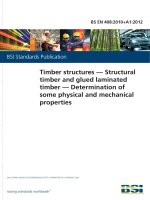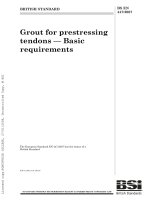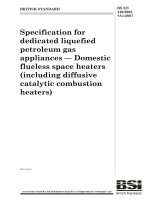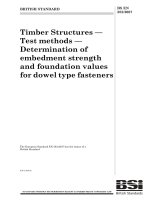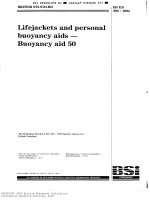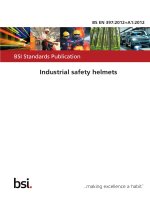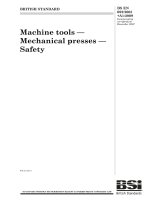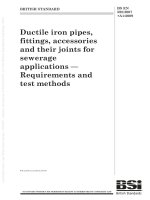Bsi bs en 10213 2007 + a1 2016
Bạn đang xem bản rút gọn của tài liệu. Xem và tải ngay bản đầy đủ của tài liệu tại đây (997.44 KB, 32 trang )
BS EN
EN
10213:2007
10213:2007
BRITISH STANDARD
Incorporating
+A1:2016
corrigendum
Incorporating
August 2008
corrigendum
August 2008
Steel castings for
pressure purposes
ICS 77. 1 40. 30
?? ? ? ????? ??????? ??? ?? ???????? ? ?? ? ?? ?? ?? ?????? ? ?? ? ? ?????? ? ???
?
?
?
?
?
?
?
?
?
?
BS EN 10213:2007+A1:2016
National foreword
This British Standard is the UK implementation of EN 10213:2007+A1:2016,
incorporating corrigendum August 2008. It supersedes BS EN 10213:2007 which
is withdrawn.
The start and finish of text introduced or altered by corrigendum is indicated in
the text by tags. Text altered by CEN corrigendum August 2008 is indicated in
the text by
.
The start and finish of text introduced or altered by amendment is indicated
in the text by tags. Tags indicating changes to CEN text carry the number of
the CEN amendment. For example, text altered by CEN amendment A1 is
indicated by
.
The UK participation in its preparation was entrusted to Technical Committee
ISE/111, Steel Castings and Forgings.
A list of organizations represented on this committee can be obtained on request
to its secretary.
This publication does not purport to include all the necessary provisions of a
contract. Users are responsible for its correct application.
Compliance with a British Standard cannot confer immunity from
legal obligations.
This British Standard was
published under the authority
of the Standards Policy and
Strategy Committee
on 30 November 2007
© The British Standards
Institution 2016.
Published by BSI Standards
Limited 2016
ISBN 978 0 580 75774 7
Amendments/corrigenda issued since publication
Date
31 January 2009
31 July 2016
Comments
Implementation of CEN corrigendum August 2008
Implementation of CEN amendment A1:2016
EN 10213:2007+A1
EUROPEAN STANDARD
NORME EUROPÉENNE
EUROPÄISCHE NORM
June 2016
ICS 77.140.30
Supersedes EN 10213:2007
English Version
Steel castings for pressure purposes
Pièces moulées en acier pour service sous pression
Stahlguss für Druckbehälter
This European Standard was approved by CEN on 11 March 2016.
CEN members are bound to comply with the CEN/CENELEC Internal Regulations which stipulate the conditions for giving this
European Standard the status of a national standard without any alteration. Up-to-date lists and bibliographical references
concerning such national standards may be obtained on application to the CEN-CENELEC Management Centre or to any CEN
member.
This European Standard exists in three official versions (English, French, German). A version in any other language made by
translation under the responsibility of a CEN member into its own language and notified to the CEN-CENELEC Management
Centre has the same status as the official versions.
CEN members are the national standards bodies of Austria, Belgium, Bulgaria, Croatia, Cyprus, Czech Republic, Denmark, Estonia,
Finland, Former Yugoslav Republic of Macedonia, France, Germany, Greece, Hungary, Iceland, Ireland, Italy, Latvia, Lithuania,
Luxembourg, Malta, Netherlands, Norway, Poland, Portugal, Romania, Slovakia, Slovenia, Spain, Sweden, Switzerland, Turkey and
United Kingdom.
EUROPEAN COMMITTEE FOR STANDARDIZATION
C O M I TÉ E URO P É E N D E N O RM ALI S ATI O N
E U RO P ÄI S C H E S KO M I T E E F Ü R N O RM U N G
CEN-CENELEC Management Centre: Avenue Marnix 17, B-1000 Brussels
© 2016 CEN
All rights of exploitation in any form and by any means reserved
worldwide for CEN national Members.
Ref. No. EN 10213:2007+A1:2016 E
BS
EN 1 021 3:2007+A1 :201(E)6
EN 10213:2007+A1:2016
EN 1 021 3:2007+A1 :201 6 (E)
Contents
Page
European foreword ....................................................................................................................................................... 3
Introduction .................................................................................................................................................................... 4
1
Scope .................................................................................................................................................................... 5
2
Normative references .................................................................................................................................... 5
■3
Terms and definitions ................................................................................................................................... 6
4
● 4.1
■ 4.2
Information to be supplied by the purchaser ....................................................................................... 6
Mandatory information ................................................................................................................................ 6
Optional information ..................................................................................................................................... 6
5
Designation........................................................................................................................................................ 6
6
6.1
6.2
■ 6.3
Manufacture ...................................................................................................................................................... 7
Manufacturing process .................................................................................................................................. 7
Welding operations ........................................................................................................................................ 7
Further processing ......................................................................................................................................... 7
7
■ 7.1
7.2
■ 7.3
●● 7.4
Requirements ................................................................................................................................................... 7
General ................................................................................................................................................................ 7
Materials ............................................................................................................................................................. 7
Casting ................................................................................................................................................................. 8
Corrosion behaviour ................................................................................................................................... 10
!
!!!
!!
"
""
8
Inspection
.......................................................................................................................................... 10
8.1
General ............................................................................................................................................................. 10
■ 8.2
Type of inspection documents and type of inspection
...................................................... 11
8.3
Test unit .............................................................................................................................................. 11
■ 8.4
Samples ............................................................................................................................................... 11
8.5
Test procedures ............................................................................................................................... 11
■ 8.6
Invalidation of test results ........................................................................................................... 11
■ 8.7 Retests .............................................................................................................................................................. 11
■ 8.8 Sorting and reprocessing .......................................................................................................................... 11
"
"
"
■9
Marking ............................................................................................................................................................ 11
■ 10
Packaging and surface protection .......................................................................................................... 11
■ 11
Complaints ...................................................................................................................................................... 11
12
Supplementary information ..................................................................................................................... 12
Annex A Welding conditions .................................................................................................................................. 21
Annex B (informative) Physical properties ....................................................................................................... 23
Annex C (informative) Creep properties ............................................................................................................. 25
!
"
Annex ZA (informative) Relationship between this European Standard and the Essential
Requirements of EU Directive
2014/68/EU
.......................................................................... 28
22
BS 10213:2007+A1:2016
EN 1 021 3:2007+A1 :201
EN
(E)6
EN 1 021 3:2007+A1 :201 6 (E)
European foreword
This document (EN 10213:2007+A1:2016) has been prepared by Technical Committee ECISS/TC 111
“Steel castings and forgings”, the secretariat of which is held by AFNOR.
This European Standard shall be given the status of a national standard, either by publication of an
identical text or by endorsement, at the latest by December 2016, and conflicting national standards
shall be withdrawn at the latest by December 2016.
This document includes Corrigendum 1 issued by CEN on 30 September 2007 and Amendment 1
approved by CEN on 11 March 2016.
This document supersedes
! EN 10213:2007" .
The start and finish of text introduced or altered by amendment is indicated in the text by tags
! ".
˜™
The modifications of the related CEN Corrigendum have been implemented at the appropriate places in
the text and are indicated by the tags
.
This document has been prepared under a mandate given to CEN by the European Commission and the
European Free Trade Association, and supports essential requirements of EU Directive(s).
For relationship with EU Directive(s), see informative Annex ZA, which is an integral part of this
document.
!revision
EN 10213:2007 " , Technical delivery conditions for steel castings for pressure purposes, ! was " a
of the European Standard, EN 10213:1995, in four parts:
—
Part 1: General
—
Part 2: Steel grades for use at room temperature and elevated temperatures
—
Part 3: Steel grades for use at low temperatures
—
Part 4: Austenitic and austenitic-ferritic steel grades
The revision
! consisted" of:
— merging of the four previous parts and new arrangement of steel grades in tables;
— GP240GR has been deleted;
— GX10NiCrSiNb32-20 has been added.
According to the CEN/CENELEC Internal Regulations, the national standards organizations of the
following countries are bound to implement this European Standard: Austria, Belgium, Bulgaria,
Croatia, Cyprus, Czech Republic, Denmark, Estonia, Finland, Former Yugoslav Republic of Macedonia,
France, Germany, Greece, Hungary, Iceland, Ireland, Italy, Latvia, Lithuania, Luxembourg, Malta,
Netherlands, Norway, Poland, Portugal, Romania, Slovakia, Slovenia, Spain, Sweden, Switzerland,
Turkey and the United Kingdom.
33
BS
EN 1 021 3:2007+A1 :201(E)6
EN 10213:2007+A1:2016
EN 1 021 3:2007+A1 :201 6 (E)
Introduction
!!
!"
"
"
This European Standard retains the same format for clauses as
EN 1559-2:2014 . This European
Standard needs to be used in conjunction with
EN 1559-2:2014 . Where no text is given under a
clause heading, the corresponding clause of
EN 1559-2:2014 applies.
The structure of this European Standard is as follows:
— clauses and subclauses preceded by ■ indicates no additional conditions to EN 1559-2;
— subclauses and paragraphs marked with a single dot ● indicate that the conditions shall be agreed
at the time of enquiry and order;
— subclauses marked with two dots ●● indicate that conditions may be agreed at the time of enquiry
and order (optional);
— subclauses without dot marking are mandatory.
4
4
BS 10213:2007+A1:2016
EN 1 021 3:2007+A1 :201
EN
(E)6
EN 1 021 3:2007+A1 :201 6 (E)
1 Scope
This European Standard applies to steel castings for pressure containing parts. It includes materials
which are used for the manufacture of components, for pressure equipment.
This European Standard relates to castings characterised by their chemical composition (see Table 2)
and mechanical properties (see Tables 3 to 6).
In cases where castings are joined by welding by the founder, this European Standard applies.
In cases where castings are welded:
— to wrought products (plates, tubes, forgings), or
— by non founders,
this European Standard does not apply.
NOTE
For this harmonised supporting standard for materials, presumption of conformity to the Essential
Requirements of the Directive is limited to technical data of the material in the standard and does not presume
adequacy of the material to specific equipment. Consequently the technical data stated in the material standard
should be assessed against the design requirements of the specific equipment to verify that the Essential
Requirements of the Pressure Equipment Directive (PED) are satisfied.
2 Normative references
!
The following documents, in whole or in part, are normatively referenced in this document and are
indispensable for its application. For dated references, only the edition cited applies. For undated
references, the latest edition of the referenced document (including any amendments) applies. "
! EN 287-1:2011" , Qualification test ofwelders — Fusion welding — Part 1: Steels
! (deleted text)"
! EN 1369:2012, Founding — Magnetic particle testing"
! EN 1370:2011, Founding — Examination ofsurface condition"
!die castings
EN 1371-1:2011, Founding — Liquid penetrant testing — Part 1: Sand, gravity die and low pressure
"
! EN 1371-2:2015, Founding — Liquid penetrant testing — Part 2: Investment castings"
! EN 1559-2:2014", Founding — Technical conditions of delivery — Part 2: Additional requirements
for steel castings
EN 10027-1:2005, ! Designation systems for steels — Part 1: Steel names"
! EN 10027-2:2015, Designation systems for steels — Part 2: Numerical system"
EN 10204:2004, Metallic products — Types of inspection documents
! (deleted text)"
EN 12680-1:2003, Founding — Ultrasonic examination — Part 1: Steel castings for general purposes
55
BS
EN 1 021 3:2007+A1 :201(E)6
EN 10213:2007+A1:2016
EN 1 021 3:2007+A1 :201 6 (E)
EN 12680-2:2003, Founding — Ultrasonic examination — Part 2: Steel castings for highly stressed
components
EN 12681:2003, Founding — Radiographic examination
! EN ISO 3452-1:2013,
"
Non-destructive testing — Penetrant testing — Part 1 : General principles
(ISO 3452-1 :201 3, Corrected version 201 4-05-01 )
EN ISO 3651-2:1998, Determination of resistance to intergranular corrosion of stainless steels — Part 2:
Ferritic, austenitic and ferritic-austenitic (duplex) stainless steels — Corrosion test in media containing
sulfuric acid (ISO 3651 -2:1 998)
! EN ISO 5579:2013,
"
Non-destructive testing — Radiographic testing of metallic materials using film
and X- or gamma rays — Basic rules (ISO 5579:201 3)
EN ISO 9934-1:2001, Non-destructive testing — Magnetic particle testing — Part 1 : General principles
(ISO 9934-1 :2001 )
! EN ISO 11970, "
! EN ISO 16810:2014,
Specification and qualification of welding procedures for production welding of steel
castings (ISO 1 1 970)
Non-destructive
testing —
Ultrasonic
testing —
General
principles
(ISO 1 681 0:201 2)
"
EN ISO 19232-1:2013, Non-destructive testing — Image quality of radiographs — Part 1 : Determination
of the image quality value using wire-type image quality indicators (ISO 1 9232-1 :201 3)
■ 3 Terms and definitions
4 Information to be supplied by the purchaser
● 4.1 Mandatory information
The relevant (ruling) wall thickness shall be agreed.
In cases of grades with different mechanical properties relating to heat treatment conditions, the
purchaser shall specify the heat treatment symbol (see Clause 5).
■ 4.2 Optional information
5 Designation
In addition to
! EN 1559-2:2014" :
Cast steels shall be designated in accordance with EN 10027-1 and EN 10027-2:
— either by their minimum yield strength (tensile test) for non alloy steels (preceded by letter P
related to pressure uses);
— or by their chemical composition for alloy steels.
6
6
BS 10213:2007+A1:2016
EN 1 021 3:2007+A1 :201
EN
(E)6
EN 1 021 3:2007+A1 :201 6 (E)
In cases of grades with different mechanical properties relating to heat treatment conditions, the
purchaser shall specify the heat treatment symbol. For example: GX8CrNi12 +QT1 or GP280GH +N.
6 Manufacture
6.1 Manufacturing process
6.1.1 Melting
In addition to
! EN 1559-2:2014" :
— alternative processes are left to the discretion of the manufacturer.
6.1.2 Heat treatment
6.1.2.1 Unless otherwise agreed, the type of heat treatment represented by its symbol shall comply
with Table 3.
■ 6.1.2.2
6.2 Welding operations
6.2.1 General
Unless otherwise agreed welding is permitted, provided that all welds shall conform to the same
criteria for non-destructive testing as the relevant part of the casting. A welding procedure qualification
is required (it may include prior agreement for major welds, weld maps…) according to EN ISO 11970.
6.2.2 Production welding
Conditions for preheat, interpass and postweld heat-treatment related to welding operations are given
in Annex A. These conditions are informative for ferritic and martensitic grades, and are normative for
austenitic and austenitic-ferritic grades.
The heat treatment procedure established to qualify the weld procedure for the austenitic and
austenitic-ferritic steels is mandatory.
6.2.3 Permanent joint welding
The welding personnel for permanent joining of components shall be qualified according to EN 287-1.
■ 6.3 Further processing
7 Requirements
■ 7.1 General
7.2 Materials
7.2.1 Chemical composition
In addition to
! EN 1559-2:2014" :
— chemical composition determined by a cast analysis shall conform with the values given in Table 2;
77
BS
EN 1 021 3:2007+A1 :201(E)6
EN 10213:2007+A1:2016
EN 1 021 3:2007+A1 :201 6 (E)
— elements unspecified shall not be intentionally added without agreement of the purchaser other
than for the purpose of finishing the heat;
!
"
— permissible deviations between the specified cast analysis and the check analysis on test blocks are
indicated
EN 1559-2:2014 ;
●● a maximum carbon equivalent value (CEV) of 0,45 % for the cast analysis may be agreed at the time
of enquiry and order for grades GP280GH (1.0625) and G20Mn5 (1.6220). The carbon equivalent value
shall be calculated according to the following formula:
CEV = C +
Mn Cr + Mo + V Ni + Cu
+
+
6
5
15
7.2.2 Mechanical properties
7.2.2.1
Table 3.
The mechanical properties at room temperature shall conform to the values given in
The mechanical properties at low temperature for impact testing:
— shall conform to the values given in Table 4 for ferritic and martensitic grades;
— ●● may be agreed to the values given in Table 5 for austenitic and austenitic-ferritic grades.
They are verified on test blocks. In all cases the maximum thickness shall be limited to 150 mm.
● In cases where the ruling thickness specified by the purchaser is above the maximum thickness given
in Table 3, the mechanical properties shall be agreed.
7.2.2.2
Proof strength at elevated temperatures shall conform to the values given in Table 6.
●● However, the verification is only made by agreement between the purchaser and the manufacturer
at the time of enquiry and order.
7.2.2.3
The values of yield and tensile strength at room temperature also apply to the casting itself
up to the maximum wall thickness as given in Table 3.
The yield strength values at room temperature correspond to:
— 0,2 % proof strength (Rp0,2 ) for ferritic, martensitic and austenitic-ferritic steels;
— 1,0 % proof strength (Rp1,0 ) for austenitic steels.
■ 7.2.3 Other properties
■ 7.3 Casting
■ 7.3.1 Chemical composition
■ 7.3.2 Mechanical properties
7.3.3
! Outer and inner conditions (non-destructive testing) "
7.3.3.1
specify:
8
8
Requirements regarding the outer and/or inner conditions shall be agreed. They shall
BS 10213:2007+A1:2016
EN 1 021 3:2007+A1 :201
EN
(E)6
EN 1 021 3:2007+A1 :201 6 (E)
— method of non-destructive testing to be used;
— extent (area and/or frequency) of testing;
— acceptance criteria.
In those areas where non-destructive testing has been agreed, the required surface condition shall be
ensured by the use of an appropriate process.
References to discontinuities shall be expressed in terms of dimension, quantity and location.
7.3.3.2
Where minor surface defects do not impair the application or if the surface of the casting
corresponds to that of the initial sample, they need not be removed.
NOTE
Examples of minor surface defects include small areas of sand or slag, small cold laps, small scabs,
small shrink-holes, groups of small pores, residues of the moulding material, uneven areas, flash.
7.3.3.3
A conforming procedure for unacceptable external and internal discontinuities may be
agreed between the purchaser and the manufacturer. In the case of as-cast castings, it is recommended
that the purchaser discusses with the manufacturer the choice of any non-destructive testing and
criteria to determine the acceptability of a subsequently machined surface. Unless specifically agreed,
discontinuities revealed on the machined surface are not to be regarded as a non-conformity.
7.3.3.4
upon.
●● If required, the surface condition including burrs and parting line flash shall be agreed
NOTE
Examples of acceptable surfaces include surface comparators or another casting used as a reference
comparator, etc.
7.3.3.5
Non destructive testing:
In addition to
! EN 1559-2:2014" :
● The castings shall be subjected to non destructive examination under conditions agreed at the time of
enquiry and order.
— every order shall include information about:
— non destructive method involved (visual, magnetic particle, liquid penetrant, ultrasonic,
radiographic …);
— severity levels for every method;
— areas of the casting to be tested (location and extent);
— percentage of castings to be inspected.
However, different acceptance criteria can be specified for different areas of the same casting (e.g. inner
and outer zones). Moreover for the same area of the casting different acceptance criteria can be
specified according to the non destructive methods selected.
The inspection shall be performed according to the relevant European Standard according to Table 1:
99
BS
EN 1 021 3:2007+A1 :201(E)6
EN 10213:2007+A1:2016
EN 1 021 3:2007+A1 :201 6 (E)
Table 1 — Inspection methods
Inspection method
Symbol
Visual
VT
Liquid penetrant
PT
Magnetic particle
MT
Ultrasonic
UT
Radiographic
RT
General principles
No
! EN ISO 3452-1"
EN ISO 9934-1
! EN ISO 16810"
! EN ISO 5579,
EN ISO 19232-1 "
Inspection conditions
! EN 1370"
EN 1371-1, EN 1371-2
EN 1369
EN 12680-1, EN 12680-2
EN 12681
■ 7.3.4 Condition of the casting
■ 7.3.5 Mass of the casting
■ 7.3.6 Additional requirements regarding the condition of the casting
●● 7.4 Corrosion behaviour
Requirements for resistance to intergranular corrosion may be agreed between the manufacturer and
the purchaser for austenitic and austenitic-ferritic grades according to EN ISO 3651-2.
8
! Inspection"
8.1 General
8.1.1 The manufacturer shall take the necessary measures to ensure compliance with the agreed
requirements. The testing shall be carried out by competent persons.
8.1.2 ●● The purchaser may agree with the manufacturer suitable measures and levels of quality
inspection, whether the inspectors have to be qualified and/or certificated, the requisite level of this
certification and the extent of the documentation of test results.
When ordering material for pressure equipment applications, the equipment manufacturer has the
obligation to request appropriate inspection documentation according to EN 10204:2004 affirming
conformity to the specification for the material contained in this European Standard.
For all products ordered to the requirements of this European Standard, specific inspection and testing
is required. This shall include the following:
— amounts of all elements specified (for the cast analysis) for the steel grade required;
— results of the mechanical tests as required for the specific steel grade in Tables 3 to 6, as applicable;
— statement on the result of agreed dimensional check and non destructive testing;
— ●● result of any further mutually agreed testing.
10
10
BS 10213:2007+A1:2016
EN 1 021 3:2007+A1 :201
EN
(E)6
EN 1 021 3:2007+A1 :201 6 (E)
■ 8.2
8.3
! Type of inspection documents and type of inspection"
! Test unit"
Formation of test units
In addition to
! EN 1559-2:2014" :
•
In the case of castings under 1 000 kg in mass the delivered quantity shall be subdivided into lots
covering castings of the same type from the same melt and having undergone the same heat
treatment. The weight of a test lot shall be not greater than 5 000 kg.
•
In the case of castings with a mass of more than 1 000 kg, each individual casting shall be regarded
as the test lot.
■ 8.4
8.5
! Samples"
! Test procedures"
■ a) Tensile test at room temperature;
■ b) ●● tensile test at elevated temperature, verification by agreement at the time of enquiry and order;
■ c) impact test;
■ d) ferrite content;
e)
hardness test (not applicable);
■ f) homogeneity of test units (hardness test);
■ g) pressure or leak testing;
■ h) intergranular corrosion test (according to EN ISO 3651-2);
■ i) tests for magnetic properties;
■ j) other tests for any other properties shall be agreed.
■ 8.6
! Invalidation of test results"
■ 8.7 Retests
■ 8.8 Sorting and reprocessing
■ 9 Marking
■ 10 Packaging and surface protection
■ 11 Complaints
11
11
BS
EN 1 021 3:2007+A1 :201(E)6
EN 10213:2007+A1:2016
EN 1 021 3:2007+A1 :201 6 (E)
12 Supplementary information
Information on physical properties and creep properties of the steel grades are given in Annex B and
Annex C.
12
12
EN 10213:2007+A1:2016 (E)
Table 2 — Chemical composition (cast analysis) (% by mass)
Designation
Name
Si
Mn
Number
P
S
max.
max.
Cr
Mo
Ni
Cu
N
V
Others
GP240GH
1.0619
0,18 to 0,23
0,60 max
0,50 to 1,20
0,030
0,020 a
0,30 b max.
0,12 b max.
0,40 b max.
0,30 max. b
-
0,03 b max
-
GP280GH
1.0625
0,18 to 0,25 c
0,60 max
0,80 to 1,20 c
0,030
0,020 a
0,30 b max
0,12 b max.
0,40 b max.
0,30 b max.
-
0,03 b max
-
G17Mn5
1.1131
0,15 to 0,20
0,60 max
1,00 to 1,60
0,020
0,020 a
0,30 b max.
0,12 b max.
0,40 b max.
0,30 max. b
-
0,03 b max.
-
G20Mn5
1.6220
0,17 to 0,23
0,60 max
1,00 to 1,60
0,020
0,020 a
0,30 max.
0,12 max.
0,80 max.
0,30 max.
-
0,03 max.
-
1.1118
0,20 to 0,25
0,60 max.
1,50 to 1,80
0,020 f
0,015
0,30 max.
0,15 max.
0,40 max.
0,30 max.
-
0,05 max.
-
G18Mo5
1.5422
0,15 to 0,20
0,60 max
0,80 to 1,20
0,020
0,020
0,30 max.
0,45 to 0,65
0,40 max.
0,30 max.
-
0,05 max.
-
G20Mo5
1.5419
0,15 to 0,23
0,60 max
0,50 to 1,00
0,025
0,020 a
0,30 max.
0,40 to 0,60
0,40 max.
0,30 max.
-
0,05 max.
-
G17CrMo5-5
1.7357
0,15 to 0,20
0,60 max
0,50 to 1,00
0,020
0,020 a
1,00 to 1,50
0,45 to 0,65
0,40 max.
0,30 max.
-
0,05 max.
-
G17CrMo9-10
1.7379
0,13 to 0,20
0,60 max
0,50 to 0,90
0,020
0,020 a
2,00 to 2,50
0,90 to 1,20
0,40 max.
0,30 max.
-
0,05 max.
-
G12MoCrV5-2
1.7720
0,10 to 0,15
0,45 max.
0,40 to 0,70
0,030
0,020 a
0,30 to 0,50
0,40 to 0,60
0,40 max.
0,30 max.
-
0,22 to 0,30
Sn: 0,025 max.
G17CrMoV5-10
1.7706
0,15 to 0,20
0,60 max.
0,50 to 0,90
0,020
0,015
1,20 to 1,50
0,90 to 1,10
0,40 max.
0,30 max.
-
0,20 to 0,30
Sn: 0,025 max.
G9Ni10
1.5636
0,06 to 0,12
0,60 max.
0,50 to 0,80
0,020
0,015
0,30 max.
0,20 max.
2,00 to 3,00
0,30 max.
-
0,05 max.
-
G17NiCrMo13-6
1.6781
0,15 to 0,19
0,50 max.
0,55 to 0,80
0,015
0,015
1,30 to 1,80
0,45 to 0,60
3,00 to 3,50
0,30 max.
-
0,05 max.
-
G9Ni14
1.5638
0,06 to 0,12
0,60 max.
0,50 to 0,80
0,020
0,015
0,30 max.
0,20 max.
3,00 to 4,00
0,30 max.
-
0,05 max.
-
GX15CrMo5
1.7365
0,12 to 0,19
0,80 max
0,50 to 0,80
0,025
0,025
4,00 to 6,00
0,45 to 0,65
-
0,30 max.
-
0,05 max.
-
GX8CrNi12
1.4107
0,10 max.
0,40 max.
0,50 to 0,80
0,030
0,020
11,50 to 12,50
0,50 max.
0,80 to 1,50
0,30 max.
-
0,08 max.
-
GX3CrNi13-4
1.6982
0,05 max.
1,00 max.
1,00 max.
0,035
0,015
12,00 to 13,50
0,70 max.
3,50 to 5,00
0,30 max.
-
0,08 max.
-
GX4CrNi13-4
1.4317
0,06 max.
1,00 max.
1,00 max.
0,035
0,025
12,00 to 13,50
0,70 max.
3,50 to 5,00
0,30 max.
-
0,08 max.
-
1.4955
0,10 to 0,14
0,20 to
0,50
0,30 to 0,80
0,020
0,010
8,00 to 9,50
0,85 to 1,05
0,40 max.
-
0,030 to 0,070
0,18 to 0,25
Nb: 0,06 to
0,10
Al: 0,020
max.
GX23CrMoV12-1
1.4931
0,20 to 0,26
0,40 max.
0,50 to 0,80
0,030
0,020
11,30 to 12,20
1,00 to 1,20
1,00 max.
0,30 max.
-
0,25 to 0,35
W: 0,50 max.
GX4CrNiMo16-5-1
1.4405
0,06 max.
0,80 max.
1,00 max.
0,035
0,025
15,00 to 17,00
0,70 to 1,50
4,00 to 6,00
0,30 max.
-
0,08 max.
-
! G24Mn6
Ferritic and martensitic
C
"
13
13
BS EN 1 021 3:2007+A1 :201 6
EN 1 021 3:2007+A1 :201 6 (E)
! GX12CrMoVNbN9–1
"
Designation
Austenitic and austenitic-ferritic
Name
C
Si
Mn
Number
P
S
max.
max.
Cr
Mo
Ni
Cu
N
V
Others
GX2CrNi19-11
1.4309
0,030 max.
1,50 max.
2,00 max.
0,035
0,025
18,00 to 20,00
-
9,00 to 12,00
0,50 max.
0,20 max.
-
-
GX5CrNi19-10
1.4308
0,07 max.
1,50 max.
1,50 max.
0,040
0,030
18,00 to 20,00
-
8,00 to 11,00
0,50 max.
-
-
-
GX5CrNiNb19-11
1.4552
0,07 max.
1,50 max.
1,50 max.
0,040
0,030
18,00 to 20,00
-
9,00 to 12,00
0,50 max.
-
-
Nb d
GX2CrNiMo19-11-2
1.4409
0,030 max.
1,50 max.
2,00 max.
0,035
0,025
18,00 to 20,00
2,00 to 2,50 9,00 to 12,00
0,50 max.
0,20 max.
-
-
GX5CrNiMo 19-11-2
1.4408
0,07 max.
1,50 max.
1,50 max.
0,040
0,030
18,00 to 20,00
2,00 to 2,50 9,00 to 12,00
0,50 max.
-
-
-
GX5CrNiMoNb19-11-2
1.4581
0,07 max.
1,50 max.
1,50 max.
0,040
0,030
18,00 to 20,00
2,00 to 2,50 9,00 to 12,00
0,50 max.
-
-
Nb d
GX2NiCrMo28-20-2
1.4458
0,030 max.
1,00 max.
2,00 max.
0,035
0,025
19,00 to 22,00
2,00 to 2,50
26,00 to
30,00
2,00 max.
0,20 max.
-
GX10NiCrSiNb32-20
1.4859
0,05 to 0,15
0,50 to
1,50
2,00 max.
0,040
0,030
19,00 to 21,00
0,50 max.
31,00 to
33,00
0,50 max
-
-
GX2CrNiMoN22-5-3
1.4470
0,030 max.
1,00 max.
2,00 max.
0,035
0,025
21,00 to 23,00
2,50 to 3,50
4,50 to 6,50
0,50 max.
0,12 to 0,20
-
GX2CrNiMoCuN25-6-3-3
1.4517
0,030 max.
1,00 max.
1,50 max.
0,035
0,025
24,50 to 26,50
2,50 to 3,50
5,00 to 7,00
2,75 to 3,50
0,12 to 0,22
-
GX2CrNiMoN25-7-3
1.4417
0,030 max.
1,00
1,50
0,030
0,020
24,00 to 26,00
3,00 to 4,00
6,00 to 8,50
1,00 max.
0,15 to 0,25
-
GX2CrNiMoN26-7-4 e
1.4469
0,030 max.
1,00 max.
1,00 max.
0,035
0,025
25,00 to 27,00
3,00 to 5,00
6,00 to 8,00
1,30 max.
0,12 to 0,22
-
a
For castings of ruling thickness < 28 mm, 0,030 S % is permitted.
b
Cr + Mo + Ni + V + Cu ≤ 1,00 %
c
For each reduction of 0,01 % below the specified maximum carbon content, an increase of 0,04 % manganese above the specified maximum content is permitted up to a maximum of 1,40 %.
d
Niobium: The Nb content shall be between 8 times the C content % present of the alloy and 1 % max.
e
For this steel grade a minimum value of the "pitting index" may be required as Pi = Cr + 3,3 Mo + 16N ≥ 40.
f
P ≤ 0,025 % is permitted if agreed between purchaser and manufacturer.
!
14
"
Nb 0,5 to 1,5
W = 1,00 max.
BS EN 1 021 3:2007+A1 :201 6
EN 1 021 3:2007+A1 :201 6 (E)
14
EN 10213:2007+A1:2016 (E)
EN 10213:2007+A1:2016 (E)
Table 3 — Mechanical properties at room temperature
Heat treatment a
Designation
Thickness
t
Rp0,2
!"
k
Name
Ferritic and martensitic
GP240GH
Number
Symbol c
1.0619
Normalizing (+N) or
quenching (+Q) or solution
annealing (+AT)
°C
900 to 980
890 to 980
900 to 980
890 to 980
890 to 980
900 to 980
900 to 940
880 to 950 l
Tempering
°C
1.0625
G17Mn5
G20Mn5
1.1131
1.6220
! G24Mn6
1.1118
G18Mo5
G20Mo5
G17CrMo5-5
G17CrMo9-10
G12MoCrV5-2
G17CrMoV5-10
G9Ni10
G17NiCrMo13-6
G9Ni14
GX15CrMo5
GX8CrNi12 e
1.5422
1.5419
1.7357
1.7379
1.7720
1.7706
1.5636
1.6781
1.5638
1.7365
1.4107
+QT3
+QT
+QT
+QT
+QT
+QT
+QT
+QT
+QT
+QT
+QT
+QT1
GX3CrNi13-4
1.6982
+QT2
+QT d
1 000 to 1 060
1 000 to 1 050
GX4CrNi13-4
1.4317
+QT
1 000 to 1 050
600 to 680
670 to 690 +
590 to 620
590 to 620
GX23CrMoV12-1
GX4CrNiMo16-5-1
1.4955
1.4931
1.4405
QT
+QT
+QT
1 040 to 1 070
1 030 to 1 080
1 020 to 1 070
730 to 760
700 to 750
580 to 630
! GX12CrMoVNbN9–1
920 to 980
920 to 980
920 to 960
930 to 970
950 to 1 000
920 to 960
830 to 890
890 to 930
820 to 900
930 to 990
1 000 to 1 060
600 to 700
600 to 700
600 to 700
610 to 660
600 to 650
t≤
650 to 680
650 to 730
650 to 730
680 to 730
680 to 740
680 to 720
680 to 740
600 to 650
600 to 640
590 to 640
680 to 730
680 to 730
t≤
t≤
MPa
min.
!"
min.
!"
Impact test
A
%
27
40
27
35
50
-
420 to 600
420 to 600
480 to 640
480 to 640
450 to 600
480 to 620
500 to 650
650 to 800
22
22
22
22
24
20
22
15
150
400
240
245
315
400
295
440
280
600
360
420
355
-
600 to 800
440 to 790
440 to 590
490 to 690
590 to 740
510 to 660
590 to 780
480 to 630
750 to 900
500 to 650
630 to 760
540 to 690
18
23
22
20
18
17
15
24
15
20
16
18
100
t ≤ 100
t ≤ 100
t ≤ 150
t ≤ 100
t ≤ 150
t ≤ 35
t ≤ 200
t ≤ 35
t ≤ 150
t ≤ 300
t≤
300
300
500
500
-
600 to 800
700 to 900
16
15
t≤
300
550
-
760 to 960
15
t ≤ 200
460
540
540
-
600 to 750
740 to 880
760 to 960
15
15
15
t≤
150
t ≤ 300
J
min.
240
240
280
280
240
300
300
500
t≤
KV2
min.
100
100
t ≤ 100
t ≤ 100
t ≤ 50
t ≤ 30
t ≤ 100
t ≤ 100
t≤
! "
60
"
27
27
40
27
27
27
45
40
50 g
27 g
27
27
60
"
15
15
BS EN 1 021 3:2007+A1 :201 6
EN 1 021 3:2007+A1 :201 6 (E)
GP280GH
+N
+QT
+N
+QT
+QT
+N
+QT
+QT2
mm
Tensile test
Rm
Rp1,0 b
k
k
MPa
MPa
Heat treatment a
Designation
Thickness
t
Number
Symbol c
GX2CrNi19-11
1.4309
+AT
GX5CrNi19-10
1.4308
+AT
GX5CrNiNb19-11
GX2CrNiMo19-11-2
1.4552
1.4409
+AT
+AT
GX5CrNiMo19-11-2
1.4408
+AT
GX5CrNiMoNb19-11-2
1.4581
+AT
GX2NiCrMo28-20-2
1.4458
GX10NiCrSiNb32-20
1.4859
Austenitic and austenitic-ferritic
Name
a
b
c
d
e
f
g
h
i
j
!
!
Normalizing (+N) or
quenching (+Q) or solution
annealing (+AT)
°C
1 050 to 1 150
1 050 to 1 150
1 050 to 1 150
1 080 to 1 150
1 080 to 1 150
1 080 to 1 150
Tempering
°C
+AT
-h
˜ GX2CrNiMoCuN25-6-3-3 ™
1.4470
+AT
1.4517
+AT
1 120 to 1 150 f
GX2CrNiMoN25-7-3
1.4417
+AT
GX2CrNiMoN26-7-4
1.4469
+AT
GX2CrNiMoN22-5-3
MPa
!"
k
min.
Tensile test
Rm
Rp1,0 b
k
k
MPa
MPa
!"
min.
!"
Impact test
A
%
80 g
60 g
t≤
150
-
210
440 to 640
30
t≤
150
-
200
440 to 640
30
-
t≤
150
150
-
200
220
440 to 640
440 to 640
25
30
-
t≤
150
-
210
440 to 640
30
-
t≤
150
-
210
440 to 640
25
1 100 to 1 180
-
t≤
150
-
190
430 to 630
30
-
-
50
180
-
440 to 640
25
180
-
400 to 600 i
20 j
t≤
1 120 to 1 150 f
1 120 to 1 150 f
1 140 to 1 180 f
J
min.
-
50 < t ≤ 150
KV2
min.
-
t≤
! "
-
t≤
150
420
-
600 to 800
20
-
t≤
150
480
-
650 to 850
22
-
t≤
150
480
-
650 to 850
22
-
t≤
150
480
-
650 to 850
22
˜ 40™
˜ 80 gg™
60
40 g
60 g
27
27
30 g
50 g
50 g
50 g
Temperature (for information only).
R p0,2 may be estimated by lowering R p1,0 by 25 MPa.
+N means Normalizing; +QT or +QT1 or +QT2 means quenching (air or liquid) + tempering; AT means: solution annealing + water quenching
Quenching in air.
The requested alternative shall be indicated on the order e.g.: GX8CrNi12 +QT1 or 1.4107 +QT1.
After solution annealing at high temperature, castings may be cooled down to between 1 050 °C and 1 010 °C prior to water quenching in order to improve corrosion resistance and prevent cracks in complex shapes.
The low temperatures impact properties shall conform to Table 4 for ferritic and martensitic grades and may be agreed according to values of Table 5 for austenic and austenic-ferritic grades used at low temperatures.
As cast conditions.
For centricast, 440 MPa to 640 MPa.
For centricast, 25 %.
"
k
1 MPa = 1 N/mm 2 .
l
Cooling in liquid (for information only).
16
mm
Rp0,2
"
BS EN 1 021 3:2007+A1 :201 6
EN 1 021 3:2007+A1 :201 6 (E)
16
EN 10213:2007+A1:2016 (E)
EN 10213:2007+A1:2016 (E)
Table 4 — Impact test at low temperature for ferritic and martensitic grades (normative)
Designation
Name
Heat treatment
Number
Symbol
! KV "
2
J
Impact test
T
°C
min.
G17Mn5
1.1131
+QT
27
- 40
+N
27
- 30
1.6220
+QT
27
- 40
1.1118
+QT2
27
- 30
+QT3
27
G20Mn5
! G24Mn6
- 30
"
G18Mo5
1.5422
+QT
27
- 45
G9Ni10
1.5636
+QT
27
- 70
G17NiCrMo13-6
1.6781
+QT
27
- 80
G9Ni14
1.5638
+QT
27
- 90
GX3CrNi13-4
1.6982
+QT
27
- 120
BS EN 1 021 3:2007+A1 :201 6
EN 1 021 3:2007+A1 :201 6 (E)
17
17
Table 5 — Impact test at low temperature for austenitic and austenitic-ferritic grades (optional)
Designation
Name
Heat treatment
Number
Symbol
! KV "
2
J
Impact test
T
°C
min.
GX2CrNi19-11
1.4309
+AT
70
- 196
GX5CrNi19-10
1.4308
+AT
60
- 196
GX2CrNiMo19-11-2
1.4409
+AT
70
- 196
GX5CrNiMo19-11-2
1.4408
+AT
60
- 196
GX2NiCrMo28-20-2
1.4458
+AT
60
- 196
1.4517
+AT
35
- 70
GX2CrNiMoN25-7-3
1.4417
+AT
35
- 70
GX2CrNiMoN26-7-4
1.4469
+AT
35
- 70
˜ GX2CrNiMoCuN25-6-3-3 ™
18
BS EN 1 021 3:2007+A1 :201 6
EN 1 021 3:2007+A1 :201 6 (E)
18
EN 10213:2007+A1:2016 (E)
EN 10213:2007+A1:2016 (E)
Table 6 — Tensile test at elevated temperatures (verification by agreement at the time of enquiry and order)
!
Designation
Heat
Proof strength test at elevated temperature
treatment
Rp0,2
MPa d min.
Name
GP240GH
Ferritic and martensitic
GP280GH
Number
Symbol
100 °C
200 °C
300 °C
350 °C
400 °C
450 °C
500 °C
550 °C
600 °C
625 °C
1.0619
+N
210
175
145
135
130
125
-
-
-
-
+QT
210
175
145
135
130
125
-
-
-
-
+N
250
220
190
170
160
150
-
-
-
-
+QT
250
220
190
170
160
150
-
-
-
-
1.0625
1.6220
+QT
270
254
244
236
225
210
189
-
-
-
G20Mo5
1.5419
+QT
-
190
165
155
150
145
135
-
-
-
G17CrMo5-5
1.7357
+QT
-
250
230
215
200
190
175
160
-
-
G17CrMo9-10
1.7379
+QT
-
355
345
330
315
305
280
240
-
-
G12MoCrV5-2
1.7720
+QT
264
244
230
-
214
-
194
144
-
-
G17CrMoV5-10
1.7706
+QT
-
385
365
350
335
320
300
260
-
-
GX15CrMo5
1.7365
+QT
-
390
380
-
370
-
305
250
-
-
GX8CrNi12
1.4107
+QT1
-
275
265
-
255
-
-
-
-
-
+QT 2
-
410
390
-
370
-
-
-
-
-
GX4CrNi13-4
1.4317
+QT
515
485
455
440
-
-
-
-
-
-
GX12CrMoVNbN9–1
1.4955
+QT
417
390
378
373
365
352
331
300
255
227
GX23CrMoV12-1
1.4931
+QT
-
450
430
410
390
370
340
290
-
-
GX4CrNiMo16-5-1
1.4405
+QT
515
485
455
-
-
-
-
-
-
-
19
BS EN 1 021 3:2007+A1 :201 6
EN 1 021 3:2007+A1 :201 6 (E)
G20Mn5
19
Designation
Heat
Proof strength test at elevated temperature
treatment
Rp1,0 a MPa d min.
Austenitic and austenitic-ferritic
Name
20
Number
Symbol
100 °C
200 °C
300 °C
350 °C
400 °C
450 °C
500 °C
550 °C
-
-
GX2CrNi19-11
1.4309
+AT
165
130
110
100
-
-
-
-
-
-
GX5CrNi19-10
1.4308
+AT
160
125
110
-
-
-
-
-
-
-
GX5CrNiNb19-11
1.4552
+AT
165
145
130
-
120
-
110
100
-
-
GX2CrNiMo19-11-2
1.4409
+AT
175
145
115
-
105
-
-
-
-
-
GX5CrNiMo19-11-2
1.4408
+AT
170
135
115
-
105
-
-
-
-
-
GX5CrNiMoNb19-11-2
1.4581
+AT
185
160
145
-
130
-
120
115
-
-
GX2NiCrMo28-20-2
1.4458
+AT
165
135
120
-
110
-
-
-
-
-
GX10NiCrSiNb32-20
1.4859
-
155
135
125
-
120
-
110
107
-
-
GX2CrNiMoN22-5-3
1.4470
+AT
330 b
280 b
c
c
c
c
c
c
-
-
1.4517
+AT
390 b
330 b
c
c
c
c
c
c
-
-
GX2CrNiMoN25-7-3
1.4417
+AT
390 b
330 b
c
c
c
c
c
c
-
-
GX2CrNiMoN26-7-4
1.4469
+AT
390 b
330 b
c
c
c
c
c
c
-
-
˜
GX2CrNiMoCuN25-6-3-3
™
a
Rp0,2 may be estimated by lowering Rp1,0 by 25 MPa.
b
Rp0,2 values instead of Rp1,0 .
c
The austenitic-ferritic steels are not to be used for temperatures higher than 250 °C in pressure vessel applications.
d
1 MPa = 1 N/mm 2 .
BS EN 1 021 3:2007+A1 :201 6
EN 1 021 3:2007+A1 :201 6 (E)
20
EN 10213:2007+A1:2016 (E)
"
BS 10213:2007+A1:2016
EN 1 021 3:2007+A1 :201(E)6
EN
EN 1 021 3:2007+A1 :201 6 (E)
Annex A
Welding conditions
Annex A is normative for austenitic and austenitic-ferritic grades.
Annex A is informative for ferritic and martensitic grades.
Table A.1 — Welding conditions
!
Designation
Interpass
temperature
°C a
°C
Post heat treatment
°C
Welding group
k
Number
GP240GH
1.0619
20 to 150
350 max.
No heat treatment necessary
C1 (B1 for +N)
GP280GH
1.0625
20 to 150
350 max.
No heat treatment necessary
C1 (B1 for +N)
G17Mn5
1.1131
20 to 150
350 max.
No heat treatment necessary
C1
G20Mn5
1.6220
20 to 150
350 max.
No heat treatment necessary
C1 (B1 for +N)
G24Mn6
1.1118
20 to 150
350 max.
l
C2 (C1 for +QT3)
G18Mo5
1.5422
20 to 200
350 max.
≥ 650
C1
G20Mo5
1.5419
20 to 200
350 max.
≥ 650
C1
G17CrMo5–5
1.7357
150 to 250
350 max.
≥ 650
C1
G17CrMo9–10
1.7379
150 to 250
350 max.
≥ 680
C1
G12MoCrV5–2
1.7720
200 to 300
400 max.
≥ 680
C1
G17CrMoV5–10
1.7706
200 to 300
400 max.
≥ 680
C1
G9Ni10
1.5636
20 to 150
350 max.
≥ 570
C1
G17NiCrMo13–6
1.6781
20 to 200
350 max.
≥ 580
C2
G9Ni14
1.5638
20 to 200
300 max.
≥ 560
C1
GX15CrMo5
1.7365
150 to 250
350 max.
≥ 650
C1
GX8CrNi12
1.4107
100 to 200
350 max.
GX3CrNi13–4
1.6982
20 to 200
GX4CrNi13–4
1.4317
100 to 200
300 max.
GX12CrMoVNbN9–1
1.4955
150 to 260
180 to 300
b
Same as normal tempering temperature
E1
b
E1
Same as normal tempering temperature
E1
Informative
Ferritic and martensitic
Name
Preheat
temperature
Major manufacturing and design welds d: E1
min. 20h, 720 °C to 740 °C after cooling
below 80 °C.
Minor manufacturing welds: min. 8h,
720 °C to 740 °C after cooling below
80 °C
GX23CrMoV12–1
1.4931
200 to 450
450 max.
≥ 680 °C after cooling under 80 °C to E1
GX4CrNiMo16–5-1
1.4405
No preheat
200 max.
Same as normal tempering temperature
130°C
E1
21
21
BS
EN 1 021 3:2007+A1 :201(E)6
EN 10213:2007+A1:2016
EN 1 021 3:2007+A1 :201 6 (E)
Designation
Interpass
temperature
°C a
°C
Post heat treatment
°C
Number
Minor welds c
Austenitic and austenitic- ferritic
Welding group
k
Major welds d
No heat tr. necess.
No heat tr. necess. e F1
GX2CrNi19–11
1.4309
GX5CrNi19–10
1.4308
GX5CrNiNb19–11
1.4552
GX2CrNiMo19–11–2
1.4409
GX5CrNiMo19–11–2
1.4408
+AT f g
F1
GX5CrNiMoNb19–11–2
1.4581
No heat tr. necess., but h
F1
GX2NiCrMo28–20–2
1.4458
20 to 100
150 max.
GX10NiCrSiNb32–20
1.4859
No preheat
200 max.
GX2CrNiMoN22–5-3
1.4470
20 to 100
250 max.
+AT i j
+AT i j
G1
GX2CrNiMoCuN25-6-3-3
1.4517
20 to 100
250 max.
+AT i j
+AT i j
G1
GX2CrNiMoN25–7-3
1.4417
20 to 100
250 max.
+AT i j
+AT i j
G1
GX2CrNiMoN26–7-4
1.4469
20 to 100
250 max.
+AT i j
+AT i j
G1
No preheat
b
+AT f g
F1
No heat tr. necess., but h
F1
No heat tr. necess.
No heat tr. necess. e F1
+AT i
No heat tr. necess.,
but c
For wall thickness > 80 mm, annealing
at ≥ 850 °C is necessary to reduce
residual stresses
F2
Normative
Name
Preheat
temperature
H1
a
The preheating temperature is related to the geometry and the thickness of the casting and climate conditions.
b
At the discretion of the manufacturer unless otherwise agreed.
c
For minor welds, where applicable, special arrangement shall be agreed upon according to corrosion conditions.
d
In general production welds are considered major when the depth of the cavity prepared for welding exceeds 40 % of the wall thickness.
e
For use at low temperature +AT is required.
f
The heat treatment for all the mentioned steels is +AT (solution annealing); it is usually made by liquid quenching or by air quenching if so agreed for
very small and thin castings.
g
For use at high temperature +AT may be suppressed.
h
For improving the corrosion resistance a special stabilizing heat treatment (stress relieve and carbide precipitation) in the range of 600 °C to 650 °C
for GX5CrNiNb19–11 and 550 °C to 600 °C for GX5CrNiMoNb19–11–2 may be agreed.
i
+AT may only be suppressed if welding is performed with restricted heat input conditions.
j
The heat treatment for all the mentioned steels is +AT (solution annealing). Air quenching may be agreed for very small and thin castings. After
solution annealing at high temperatures, castings may be cooled down to between 1 050 °C and 1 010 °C prior to water quenching in order to improve
corrosion resistance and prevent cracks in complex shapes.
k
See EN ISO 11970.
l
The post weld heat treatment temperature shall be at least 20 °C but not more than 50 °C below the tempering temperature, (e.g.: for a tempering
temperature of 650 °C the post weld heat treatment temperature shall be between 600 °C and 630 °C).
"
22
22
BS 10213:2007+A1:2016
EN 1 021 3:2007+A1 :201(E)6
EN
EN 1 021 3:2007+A1 :201 6 (E)
Annex B
(informative)
Physical properties
Information on physical properties of steel grades is given in Table B.1.
Table B.1 — Physical properties (informative)
at
Name
Number
10 -6 K-1
Thermal
conductivity
W/(m.K)
Specific
heat
J/(kg.K)
from
at
at
Mean thermal expansion
20 °C to
20 °C to
20 °C to
20 °C
100 °C
300 °C
500 °C
50 °C
100 °C
20 °C
GP240GH
1.0619
7,8
12,6
13,4
14
45
-
460
GP280GH
1.0625
7,8
12,8
13,6
14,5
45
-
460
G17Mn5
1.1131
7,8
13,0
13,8
15
45
-
460
G20Mn5
1.6220
7,8
13,0
13,8
15
45
-
460
G18Mo5
1.5422
7,85
12,4
13,1
13,8
43
-
460
G20Mo5
1.5419
7,85
12,4
13,1
13,8
43
-
460
G17CrMo5-5
1.7357
7,85
11,8
12,9
13,7
38,5
-
460
G17CrMo9-10
1.7379
7,85
11,8
12,6
13,4
-
-
460
G12MoCrV5-2
1.7720
7,85
-
-
-
-
-
460
G17CrMoV5-10
1.7706
7,85
12,4
13,6
14,5
-
-
460
G9Ni10
1.5636
7,85
11,8
12,4
13,6
36
-
460
G17NiCrMo13-6
1.6781
7,85
-
-
-
-
-
460
G9Ni14
1.5638
7,85
-
-
-
-
-
460
GX15CrMo5
1.7365
7,8
11,8
12,3
12,7
30,1
-
460
GX8CrNi12
1.4107
7,7
10,5
11,5
12,3
26
27
460
GX4CrNi13-4
1.4317
7,7
10,5
11
12
26
27
460
1.4955
7,77
10,8
11,5
12,1
25,7
26,4
GX3CrNi13-4
1.6982
7,7
10,5
11
12
26
27
460
GX23CrMoV12-1
1.4931
7,7
-
-
-
-
-
460
GX4CrNiMo16-5-1
1.4405
7,8
10,8
11,5
12
17
18
460
GX2CrNi19-11
1.4309
7,88
16,8
17,9
18,6
15,2
16,5
530
GX5CrNi19-11
1.4308
7,88
16,8
17,9
18,6
15,2
16,5
530
GX5CrNiNb19-11
1.4552
7,88
16,8
17,9
18,6
15,2
16,5
530
GX2CrNiMo19-11-2
1.4409
7,9
15,8
17
17,7
14,5
15,8
530
GX5CrNiMo19-11-2
1.4408
7,9
15,8
17
17,7
14,5
15,8
530
GX5CrNiMoNb19-11-2
1.4581
7,9
15,8
17
17,7
14,5
15,8
530
GX2NiCrMo28-20-2
1.4458
8,0
14,5
16,2
17
16
17
500
GX10NiCrSiNb 32-20
1.4859
8,0
-
15
16,3
12,1
13,1
500
! GX12CrMoVNbN9–1
456
Magnetic
properties
Magnetic
Density
kg/dm3
"
Non to slight magnetic
Designation
23
23
